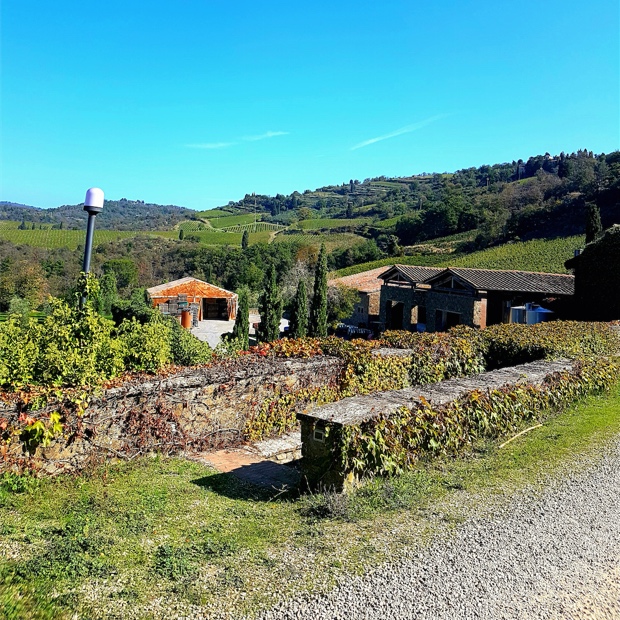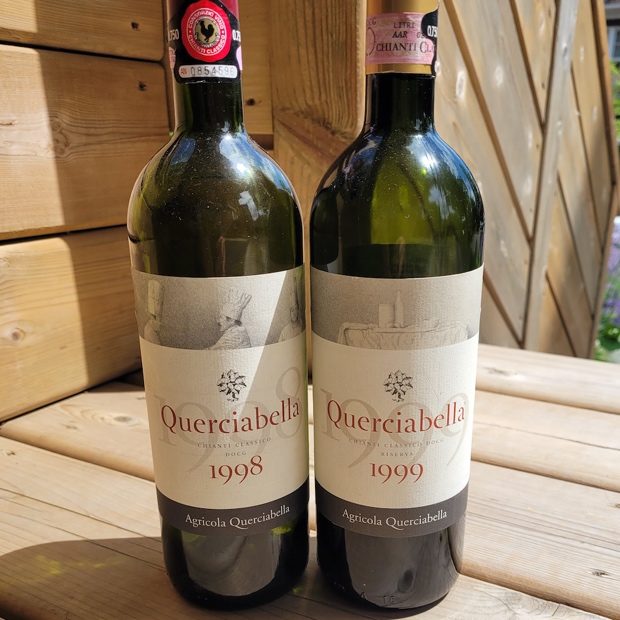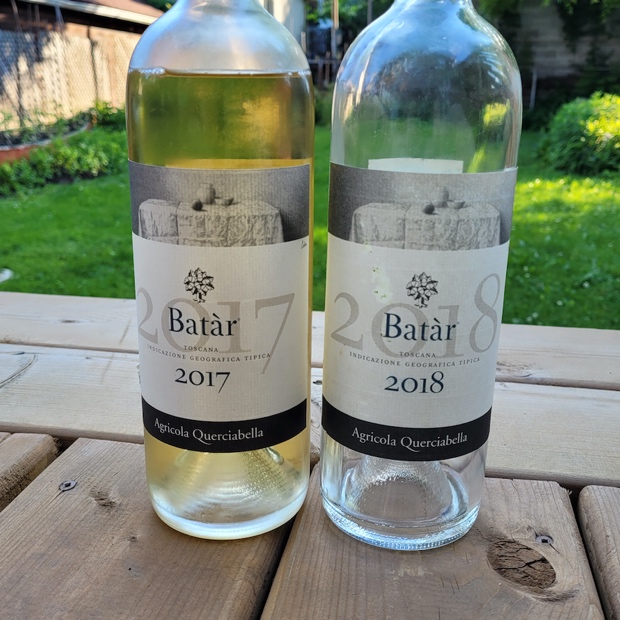A few years back I made my first visit to Querciabella, in September 2017, to be exact. Their position in Ruffoli east of the Greve hamlet and the eponymous river is one of the most distinct and perhaps least travelled of Greve’s frazioni. With stunning views towards the Val di Greve, the Colle di Panzano and the amphitheatre of Lamole, Ruffoli carries its very own perspective, one that is unlike any other perch where the Classico are made in Chianti. Several weeks ago I caught up with Querciabella’s n groot winemaker Manfred Ing for a virtual session, replete with a ten-deep taste through of his (and their) lekker wines.
Related – A river runs through Greve
The Ruffoli hill may not qualify for Chianti Classico’s newly minted UGA (Ùnita Geografiche Aggiuntive), but make no mistake. Ruffoli is the definition of a communal sub-zone in requiem of introspective investigation for its distinct soils, elevation, singularities and peculiarities. It is, as I have said before, “the Chianti Classico poster child for seeing the vineyards through the trees.” Along with Jurji Fiore’s Poggio Scalette and Il Tagliato by Marco e Elena Kupfer there forms a special bond for Ruffoli’s combination of elevation, thick forests and conglomerate soils that have been excavated from beneath those heavy woods. If Querciabella’s decisive resource and secret weapon are vineyard holdings in two other Classico communes, those being Radda and Gaiole, Ruffoli remains the epicentre and the wines can be imagined as residing at the rooftop and pinnacle of Chianti Classico.
Querciabella was founded in 1974 by Giuseppe (Pepito) Castiglioni. His son Sebastiano Cossia Castiglioni, investor and entrepreneur, converted the estate to organic viticulture in 1988, making Querciabella one of the first wineries in Italy to employ this practice. In 2000 Sebastiano introduced a 100 per cent plant‑based approach to biodynamics that forbids the use of animal products in both the vineyards and in the cellars. The Chianti Classico estate that means “beautiful oak” has always been one that lives for today while always imagining and thinking about tomorrow. The wines arguably act as the most Bourguignons of any in the territory whilst always and unequivocally speaking for the land that gives them life.
In April of this year I asked Ing to assess the damage caused by uncharacteristic mid-Spring frosts. His response: “Unfortunately the cold weather that swiped through Tuscany on the April 6th and 7th caused us some frost damage, having hit especially those vineyards which were ahead in their development. Our team lead by Dales is still assessing the damage and it’s early to say how the affected vineyards will recuperate. We will know better in the coming weeks as the vines develop. In Chianti Classico, where our vineyard holdings are spread in different locations and altitude, isolated pockets of lower lying vineyards were affected, especially those around and below our cellar in Ruffoli. At a first glance, it appears that the frost bite hit some of the early budding Chardonnay and the young Sangiovese vines that were first out the blocks. Most of the higher altitude vineyards buds haven’t fully burst yet, so we are fortunate and remain hopeful. In Maremma, temperatures dipped to record lows in some areas, especially in the early hours of April 8th. The Sangiovese vines had an early start this year so were particularly exposed. Vines are an extraordinary plants which are known for bouncing back. At this stage we can only wait and see. It’s already clear, though, that we are among many other producers concerned about losing some crop to frost damage.”
It remains to be seen how pandemic and travel will play out over these next several weeks but I have every intention of climbing the Ruffoli hill this coming September (or anytime such an endeavour is possible) to see Manfred and team for a walk in the vineyards and a sit-down to taste more from their most excellent portfolio; Vineyard Operations Manager & Master Beekeeper Catiuscia Minori, Agronomist Chiara Capecci, Agronomist & Technical Director Dales D’Alessandro, Direct Sales & Visits Coordinator Daniela Krystyna Cappuccio, Head of Marketing and Communications Emilia Marinig, Global Sales Director Giorgio Fragiacomo, Winemaker Guido De Santi, Winemaking Director Luca Currado, Agronomist & Operations Manager Marco Torriti, CEO & Domestic Sales Director Roberto Lasorte, Marketing Assistant Manager Valentina Bertoli and of course Owner and Honorary Chairman Sebastiano Cossia Castiglioni. In the meantime here are the 10 wines we tasted and discussed back on May 31, 2021.

Felt quite real to be talking Ruffoli, Greve, Maremma, Gaiole and Radda with Tuscany’s groot South African winemaker @bottleofgrapes ~ A virtual session with @querciabella maintains the ties that bind with @chianticlassico
Querciabella Mongrana 2019, Marermma Toscana DOC (13653, $23.95)
From 31 hectares south of Grosseto, divided into two re-planted parcels purchased in 1998-1999 near to Alberese, a village and frazione of the commune. Wines are crushed and fermented in Maremma and then transferred to Greve just before or just after malo takes place. The style comes from cement and stainless steel, of fruit purity kept intact and a coastal influence developing some muscle. Picked ahead of Chianti Classico with harvest always beginning two to two and a half weeks ahead of Greve. So much Tuscan coastal bushy and dusty herbology, of fennel and rosemary primarily. Managed by Agronomist & Operations Manager Marco Torriti and team who are responsible for this 50-25-25, sangiovese led blend with cabernet sauvignon and merlot. Drink this by the glass everywhere you go, matching the pasta shape on the bottle, if you are so inclined, wherever possible. Mongrana goes as does L, Maquis shrubland ingrained into an easy drinking, fun, juicy and exuberant blend. Will never mess with any course, nor wine that comes before or after. Has been labelled DOC Maremma since 2017. Drink 2021-2024. Tasted May 2021
Querciabella Chianti Classico DOCG 2018 (728816, $45.95)
Remains 100 per cent sangiovese, as it has been since 2012, as a three-commune collection; Ruffoli in Greve (40 per cent), on the Volpaia side and across the valley to Radda (20) and San Polo in Rosso from Gaiole (20), across the ravine from Ama. The totality of the Gaiole fruit is raised on Alberese, the Radda in schisty Galestro and Ruffoli, well Ruffoli is really about elevation. A no extremities vintage following a very cold winter and no climate spikes save for the early August heat. The Querciabella richness is foiled but also optimized by a three-part mineral harmony that does not so much cut but adds three district notes to the wine. The epiphany may or not begin with this 2018 but the textural perception has undergone a transformational alteration, now in defence against the drying effect of sangiovese’s tannin. The winemaking team has moved forward from the experimental stage into a full-on working contract with Piedmontese cappello sommerso, keeping the cap submerged for extended periods (up to 45 days). The high elevation fruit is particularly promising, forging true connectivity with the process. You get it completely, intuit the polish and this Annata just melts straight into inherit structure, again with thanks for a portion that has settled early. The wheel is constantly turning for Querciabella’s wines. Stupendo. Drink 2022-2032. Tasted May 2021
Querciabella Chianti Classico Riserva DOCG 2017 ($79.95)
Riserva, like most Riservas in Chianti Classico is usually more serious, often blended with cabernet sauvignon and/or merlot, subjected to more wood. Since 2011 Querciabella’s has been 100 per cent sangiovese but still a three commune (Greve, Radda and Gaiole) cuvée, a vibrant varietal wine, lush as it needs to be and what stands apart is its simple purity. The picking decisions are made throughout the season, not just at harvest and certain blocks are given the attention of dramatic foreshadowing. Riserva by Querciabella is a wine of evolution, including monthly tastings along the way (with 20 per cent new wood involved). Riserva is a factor of a trajectory, of sangiovese that is always rising, gaining character, fortitude and fruit in vessel that winemaker Manfred Ing knows in his heart is meant for Riserva. The tannins tell the story, croccante is how he describes or the flavour and texture he looks for, in my mind like crunchy and caramelized almonds and dried wild strawberries of a concentrated yet developing sweetness. A wine to age, surely, though not quite like ’16, but do sleep on this because the efficacy, youthful binding and wound intensity show the promise of great ability. Drink 2023-2030. Tasted May 2021
Querciabella Turpino 2017, IGT Toscana ($59.95)
First commercial vintage was 2010 when at the time it was 50-50 Maremma and Greve. Since 2015 it identifies as 100 per cent Tuscan coast with more barrel exercise and power than Mongrana, now a cuvée of approximately 12,000 bottles. “Turpino,” as in a character from Sebastiano Cossia Castiglioni’s favourite poem, like his son Orlando (and also for the names Mongrana and Palafreno). Frost was a major problem in 2017, followed by heat, no rain and vines that just went crazy. Small pickings were done in the first week of September and then the rain came. The vines dropped in alcohol potential by a degree but the vines were tired and so the fruit could not hang in there like it could (better so) in Ruffoli. A blend of 40 per cent each cabernet franc and syrah with (20) merlot. Spiciness but not in a traditionally Tuscan syrah (Cortona) way and so the franc is to thank for the pique, sharpness and pointed directive of this ripe wine agitative of pricks and sway. In the end this is truly Tuscan coast, carrying the dried and bushy herbs but with an extended olive branch, muscular arm and structured savour. Only 10,000 bottles were made of this succulent, strange bedfellows (for Tuscany) red wine. House wine, Querciabella style. Drink 2023-2028. Tasted May 2021
Querciabella Camartina 2016, IGT Toscana
The first vintage for Camartina was 1981, originally mostly sangiovese, then in and around 2001-2003 turning towards becoming mostly cabernet sauvignon. Now at 70 per cent with (30) sangiovese since that 2003. With the most spectacular vintage in pocket the possibility and even more so the probability from 2016 is endless. A Vino da Tavola concept that has evolved to make for the most mature, wise and complex IGT from Ruffoli hillsides, but this vintage shows a special energy, liveliness and vim from acidity that gives the wine, regardless of grape varieties, so much youth and life. Another one of nature’s and Greve’s mysterious constants. So Querciabella, of pinpointed DNA. vibrancy and length. Drink 2023-2033. Tasted May 2021
Querciabella Palafreno 2016, IGT Toscana ($214.95)
Since 2004 has always been 100 per cent merlot, before that being a 50-50 sangiovese and merlot joint. Has to be an ideal vintage for Sebastiano and Manfred to bottle this idealistic wine because it has to, must smell like Tuscany and Ruffoli. Places home to poetic settings which suggest inner meaning and invisible connections. With that essence of 2016, of high priority acidity, sapidity and vibrancy in mind, this drinks so well and truth is shows how merlot has been domesticated upon the Ruffoli hill. The vines average 20 years of age, with some vines nearly at 30, planted in 1995 and/or 1996. Sweet, verdant and grippy tannins with a little bit of grit are surely involved. This will show off some swarthy secondary character and essenza di tartufo in 10 years time. Only 3,000 bottles are made. Drink 2021-2031. Tasted May 2021
Querciabella Chianti Classico DOCG 1998 (728816, Price at release: $31.95)
Twenty plus years later and not by any means over the hill. Drinking with captured and preserved youth from a vintage that was passed over for being one to not give any sort of great attention or consideration. Fermented in 225L (some new wood) barrels, some big tanks, picked later than most Chianti Classico of the time and would not have been pure sangiovese. You can feel the botrytis induced blood orange and saffron from a vintage with pioggia, pioggio, pioggia, a.k.a. so much rain. Also liquorice, bokser pod and a smell of wet tar. Really textural Classico, holding firm and strong, with a few years of interest and more complexity developing potential left to seek out. Charm begets pleasure which leads to unadulterated enjoyment. Drink 2021-2024. Tasted May 2021
Querciabella Chianti Classico Riserva DOCG 1999
The 1999 was the last (original) Riserva produced until it was again resurrected in 2011 and what’s so cool about this vintage is how it was held to some early esteem, though paling in comparison to that “vintage of the century” that was 1997. Underestimated over the last 20 years, drinking so beautifully now, with frutta di bosca, tertiary tartufo and fungi. Just doesn’t strike as a fully mature adult reminiscing about the way things used to be but more like a wine with an outlook for more promise, good times and adventures still ahead. If you are still holding onto ‘99s from this part of Toscana you will be very pleased. Drink 2021-2026. Tasted May 2021
Querciabella Batàr 2018, Toscana IGT ($149.95)
A joint between pinot blanc and chardonnay, whole bunch pressed, with furthered finer attention to detail, picked early in the morning and a decreased amount of new oak over the last 10 years. Now at about 20 per cent and less bâtonnage as well, keeping the strings tight and the backbone straight in the wine. “We don’t need to worry about getting richness in our wines,” tells Manfred Ing, and yes, the creaminess is automatic. There’s more bite to Batàr now, along with focus and precision, with an intention to allow for five (minimum) years ahead for energy to develop, flesh to increase and textural richness to become something naturally orchestrated over time. Batàr is a wine that defies flamboyance, deflates extroversion and muffles the most exultant cry. It knows what it is and what’s up. Terrific vintage for this singular, dual-focused and one goal achieved Querciabella bianco. Drink 2024-2029. Tasted May 2021
Querciabella Batàr 2017, Toscana IGT ($149.95)
The effect of 2017 on white grapes meant a 40 per cent reduction in quantity and chardonnay surely suffered. Certainly true at 350m (south-facing) but also at 600m (on sandstone soils) where it thrives. The pinot bianco faces north so it did well in the season. The flinty reduction comes from the high elevation vineyard and you really notice it more in 2017, but also a fruit sweetness, like biting into a perfectly ripe apple, and also a peach. You still need to exercise patience with this wine because what it really shows you is how this particular cuvée will morph, oscillate and change, for sure and at least in its first five years. Definitely buttery, rich and creamy but let’s not sit on those laurels for too long because herbs, sapidity and a new kind of vim and vigour are just around the corner. A concentrated effort and one with many tricks up its Ruffoli sleeve. Drink 2022-2027. Tasted May 2021
Good to go!
godello
Twitter: @mgodello
Instagram: mgodello







